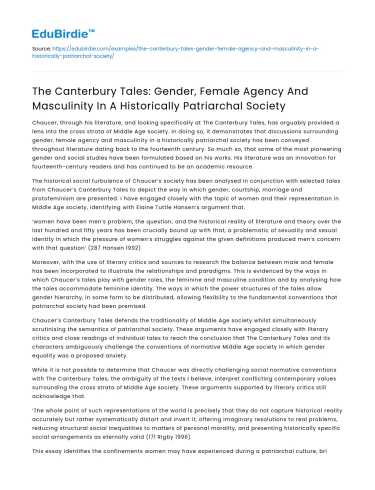Chaucer, through his literature, and looking specifically at The Canterbury Tales, has arguably provided a lens into the cross strata of Middle Age society. In doing so, it demonstrates that discussions surrounding gender, female agency and masculinity in a historically patriarchal society has been conveyed throughout literature dating back to the fourteenth century. So much so, that some of the most pioneering gender and social studies have been formulated based on his works. His literature was an innovation for fourteenth-century readers and has continued to be an academic resource.
The historical social turbulence of Chaucer’s society has been analysed in conjunction with selected tales from Chaucer’s Canterbury Tales to depict the way in which gender, courtship, marriage and protofeminism are presented. I have engaged closely with the topic of women and their representation in Middle Age society, identifying with Elaine Tuttle Hansen’s argument that.
Save your time!
We can take care of your essay
- Proper editing and formatting
- Free revision, title page, and bibliography
- Flexible prices and money-back guarantee
‘women have been men’s problem, the question; and the historical reality of literature and theory over the last hundred and fifty years has been crucially bound up with that, a problematic of sexuality and sexual identity in which the pressure of women’s struggles against the given definitions produced men’s concern with that question’ (287 Hansen 1992)
Moreover, with the use of literary critics and sources to research the balance between male and female has been incorporated to illustrate the relationships and paradigms. This is evidenced by the ways in which Chaucer’s tales play with gender roles, the feminine and masculine condition and by analysing how the tales accommodate feminine identity. The ways in which the power structures of the tales allow gender hierarchy, in some form to be distributed, allowing flexibility to the fundamental conventions that patriarchal society had been premised.
Chaucer’s Canterbury Tales defends the traditionality of Middle Age society whilst simultaneously scrutinising the semantics of patriarchal society. These arguments have engaged closely with literary critics and close readings of individual tales to reach the conclusion that The Canterbury Tales and its characters ambiguously challenge the conventions of normative Middle Age society in which gender equality was a proposed anxiety.
While it is not possible to determine that Chaucer was directly challenging social normative conventions with The Canterbury Tales, the ambiguity of the texts I believe, interpret conflicting contemporary values surrounding the cross strata of Middle Age society. These arguments supported by literary critics still acknowledge that.
‘The whole point of such representations of the world is precisely that they do not capture historical reality accurately but rather systematically distort and invert it, offering imaginary resolutions to real problems, reducing structural social inequalities to matters of personal morality, and presenting historically specific social arrangements as eternally valid (171 Rigby 1996)
This essay identifies the confinements women may have experienced during a patriarchal culture, bringing to attention the fears and anxieties that endangered the masculine condition. I have suggested that female characters, such as, Griselda, Dorigen and Emelye embody extreme feminine characteristics that threaten the masculinity of their tales society and create an opening for female independent thought. While demonstrating how Alison’s character in The Wife of Bath challenges the foundations of patriarchal society and embodies the fundamental characteristics, we would associate in a modern world with feminism. These points work in conjunction with the argument that,
‘given that the male was taken as the norm and women as the ‘marked case’, medieval attitudes to gender tended to be most explicitly formulated in discussions of women’s nature’ (119-20 Rigby 1996)
Chaucer represents individual questions of morality within the tales highlighting aspects such as betrayal, infidelity, the mockery of marriage and the supposed inferiority of women with a believable backdrop of Middle Age England. This essay has used this to provide an argument that Chaucer’s Canterbury Tales, with its inclusion of relatable characters, suggest an alternative perspective of Middle Age society.






 Stuck on your essay?
Stuck on your essay?

